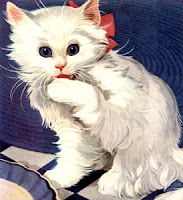All sight word lists are the same and in the same order. The list was devised by teachers Fry and Dolch who realized that children were much more successful when they knew the words "on sight, instantly."
The reason these words are so important is that they are the service words of the language. They recur over and over on every page. Many cannot be sounded out and do not even register as words to young children because they have vague, hard-to-explain meanings.
Sentences and stories provide lots of repetition with the various sight words; giving your child lots of practice with lots of sight words. This is the most effective way of learning these words.
Using the top sentence in the story below: help your child put his finger under each word as you read. After you have read the 1st sentence three times, let your child read the word the by himself as you come to it while rereading the sentence together. Use the same steps on the 2nd sentence. Eventually read the whole story together, with your child pointing to each word, and saying the words as he begins to recognize them. Your goal is the, additional words are a bonus. In this story, only cat and white are not sight words.
Do you like the cat?
I like the pretty cat.
The cat is white. I will give the cat a name.
I will give the cat the name _____________.
Ask your child to count how many times he sees the in this story (6 times). Ask your child to print the word the - many times, at different times. Ask your child to point to and read the as you read other stories together. Expect learning a word to take several short, fun sessions.
I use eBay as my website. Search Instant Reading Help kindergarten. Or Instant Reading Help plus your child's grade level. Have fun reading with your child. Thank you, Mary Maisner
The reason these words are so important is that they are the service words of the language. They recur over and over on every page. Many cannot be sounded out and do not even register as words to young children because they have vague, hard-to-explain meanings.
Sentences and stories provide lots of repetition with the various sight words; giving your child lots of practice with lots of sight words. This is the most effective way of learning these words.
Using the top sentence in the story below: help your child put his finger under each word as you read. After you have read the 1st sentence three times, let your child read the word the by himself as you come to it while rereading the sentence together. Use the same steps on the 2nd sentence. Eventually read the whole story together, with your child pointing to each word, and saying the words as he begins to recognize them. Your goal is the, additional words are a bonus. In this story, only cat and white are not sight words.
Do you like the cat?
I like the pretty cat.
The cat is white. I will give the cat a name.
I will give the cat the name _____________.
Ask your child to count how many times he sees the in this story (6 times). Ask your child to print the word the - many times, at different times. Ask your child to point to and read the as you read other stories together. Expect learning a word to take several short, fun sessions.
I use eBay as my website. Search Instant Reading Help kindergarten. Or Instant Reading Help plus your child's grade level. Have fun reading with your child. Thank you, Mary Maisner













